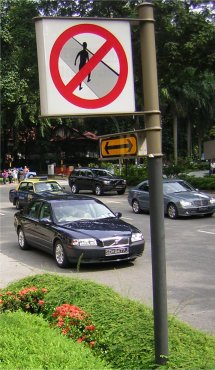Jaywalking
Jaywalking refers to the act of pedestrians crossing a road or street unlawfully or without regard for approaching traffic. The term originated in the United States in the early 20th century, combining the word "jay," an outdated slang term meaning a foolish person, with "walking." This practice is often considered dangerous and is illegal in many jurisdictions because it disrupts the flow of traffic and increases the risk of accidents.
Definition and Origin[edit | edit source]
Jaywalking is defined as crossing a street outside of a marked crosswalk or not adhering to pedestrian traffic signals. The term is believed to have been coined to describe careless pedestrians in a derogatory manner, likening them to "jays," or inexperienced people unfamiliar with urban environments. The concept became more prevalent with the rise of automobiles and the need to regulate pedestrian and vehicular traffic for safety reasons.
Legal Aspects[edit | edit source]
The legality of jaywalking varies by jurisdiction. In many countries, including parts of the United States, United Kingdom, and Australia, laws prohibit jaywalking to reduce traffic accidents. Penalties for jaywalking can range from verbal warnings to fines or, in rare cases, arrest. However, enforcement intensity and public awareness of jaywalking laws can vary significantly from one place to another.
Safety Concerns[edit | edit source]
Jaywalking poses significant safety risks. Pedestrians crossing roads irregularly or without caution are more susceptible to being hit by vehicles, potentially resulting in serious injury or death. Traffic engineers and safety advocates emphasize the importance of using designated crossing points and obeying pedestrian signals to mitigate these risks.
Cultural Perspectives[edit | edit source]
Attitudes towards jaywalking vary culturally. In some cities, jaywalking is seen as a minor offense and is commonly practiced by pedestrians. In contrast, other places have strict enforcement of jaywalking laws, reflecting a cultural emphasis on order and pedestrian safety. These differences often stem from the local urban design, public transportation availability, and societal attitudes towards rules and regulations.
Prevention and Education[edit | edit source]
Efforts to reduce jaywalking typically involve a combination of law enforcement, public education campaigns, and urban planning measures. Educating the public about the dangers of jaywalking and the importance of using crosswalks can help change behaviors. Additionally, improving pedestrian infrastructure, such as adding more crosswalks and pedestrian signals, can encourage safer crossing practices.
Conclusion[edit | edit source]
Jaywalking is a complex issue that involves legal, safety, and cultural dimensions. While it is often viewed as a minor infraction, the potential consequences of jaywalking underscore the importance of adhering to pedestrian laws and practices. Through a combination of enforcement, education, and infrastructure improvements, communities can work towards reducing jaywalking incidents and enhancing overall pedestrian safety.
Search WikiMD
Ad.Tired of being Overweight? Try W8MD's physician weight loss program.
Semaglutide (Ozempic / Wegovy and Tirzepatide (Mounjaro / Zepbound) available.
Advertise on WikiMD
|
WikiMD's Wellness Encyclopedia |
| Let Food Be Thy Medicine Medicine Thy Food - Hippocrates |
Translate this page: - East Asian
中文,
日本,
한국어,
South Asian
हिन्दी,
தமிழ்,
తెలుగు,
Urdu,
ಕನ್ನಡ,
Southeast Asian
Indonesian,
Vietnamese,
Thai,
မြန်မာဘာသာ,
বাংলা
European
español,
Deutsch,
français,
Greek,
português do Brasil,
polski,
română,
русский,
Nederlands,
norsk,
svenska,
suomi,
Italian
Middle Eastern & African
عربى,
Turkish,
Persian,
Hebrew,
Afrikaans,
isiZulu,
Kiswahili,
Other
Bulgarian,
Hungarian,
Czech,
Swedish,
മലയാളം,
मराठी,
ਪੰਜਾਬੀ,
ગુજરાતી,
Portuguese,
Ukrainian
Medical Disclaimer: WikiMD is not a substitute for professional medical advice. The information on WikiMD is provided as an information resource only, may be incorrect, outdated or misleading, and is not to be used or relied on for any diagnostic or treatment purposes. Please consult your health care provider before making any healthcare decisions or for guidance about a specific medical condition. WikiMD expressly disclaims responsibility, and shall have no liability, for any damages, loss, injury, or liability whatsoever suffered as a result of your reliance on the information contained in this site. By visiting this site you agree to the foregoing terms and conditions, which may from time to time be changed or supplemented by WikiMD. If you do not agree to the foregoing terms and conditions, you should not enter or use this site. See full disclaimer.
Credits:Most images are courtesy of Wikimedia commons, and templates Wikipedia, licensed under CC BY SA or similar.
Contributors: Prab R. Tumpati, MD

